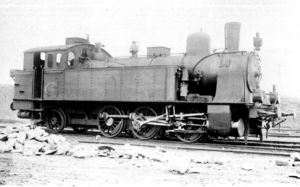CN 1-4
| CN 1-4 | |
|---|---|
|
KN 2, around 1912
|
|
| Numbering: |
KN 1 - 4 DR 90 6401 and 6402 |
| Number: | 4th |
| Manufacturer: |
Borsig serial number 5184-5186, 6810 |
| Year of construction (s): | 1903, 1908 |
| Retirement: | until 1955 |
| Type : | C1 'n2t |
| Gauge : | 1435 mm ( standard gauge ) |
| Length over buffers: | 11,320 mm |
| Total wheelbase: | 6,100 mm |
| Empty mass: | 42 t |
| Service mass: | 54 t |
| Friction mass: | 43.25 t |
| Top speed: | 50 km / h |
| Driving wheel diameter: | 1,250 mm |
| Impeller diameter: | 1,000 mm |
| Control type : | Allan |
| Cylinder diameter: | 430 mm |
| Piston stroke: | 630 mm |
| Boiler overpressure: | 12 bar |
| Grate area: | 1.53 m² |
| Evaporation heating surface: | 107.935 m² |
| Water supply: | 5.8 m³ |
| Fuel supply: | 1.5 t |
| Brake: |
Westinghouse brake throw lever handbrake |
The tank locomotives KN 1-4 with the wheel arrangement C1 'were procured by Borsig for the Kleinbahn AG Cassel-Naumburg (KN) and were the company's first locomotives. They were later replaced by more powerful locomotives. After being used by other private railways, the last two examples came to the then Deutsche Reichsbahn after the Second World War and were used here as the DR class 90.64 . The locomotives were retired and scrapped in the mid-1960s.
history
Kleinbahn AG Cassel-Naumburg
As original equipment for locomotives, Kleinbahn AG Cassel-Naumburg attached great importance to adequately tested machines, and so they ordered three machines from Borsig that were based on the Prussian T 9.1 . The locomotives were delivered in 1903 and were given the road numbers 1 to 3 with the addition of Klb.C.-N. The locomotives had a top speed of 50 km / h, which was sufficient for the KN route, which was then approved for 40 km / h.
The KN 3 proved to be very prone to failure during operation, so that in 1908 another machine of the same type was put into service. In the early days, the locomotives met the requirements of Kleinbahn AG Cassel-Naumburg; for larger loads, the trains were driven with a leader . When the train loads increased from 1925, the locomotives had to give way to the more powerful ELNA replicas .
Eberswalde-Finowfurt Railway
The machines came to the Eberswalde-Finowfurt Railway (EFE) , some of them via intermediate stations . In 1925 these were the KN 2 and KN 4 , which were designated there as EFE 1 II and EFE 2 II . The locomotive EFE 1 was the main locomotive in Eberswalde and remained until well over the Second World War, the locomotive EFE 2 was rented out several times and returned during the war.
The KN 1 came to the Kleinbahn Bremen – Thedinghausen (BTh) in 1927 and from there to the EFE in 1944. There the locomotive was taken out of service in 1936 due to persistent boiler problems.
The KN 3 came to the Freie Grunder Eisenbahn as locomotive 4 in 1926 , from where it was rented to Kleinbahn AG Cassel-Naumburg several times. On April 1, 1943, the locomotive also came to the Eberswalde-Finowfurt Railway as EFE 3 , where it was retired in 1949.
Post-war homes
Deutsche Reichsbahn 90.64
In December 1949, the Eberswalde-Finowfurt Railway was nationalized, so that the EFE 1 and EFE 2 came to the Deutsche Reichsbahn and were referred to here as 90 6401 and 90 6402 . The 90 6401 is known to have been used by the Reichsbahndirektion Greifswald , the location of the 90 6402 is not known. Both locomotives were retired from the Deutsche Reichsbahn in 1953 and 1955, but continued to be used.
The 90 6401 came in 1953 as locomotive 3 to the Edelstahlwerk Freital , the 90 6402 came as locomotive 6 to the large coking plant Matyas Rakosi in Lauchhammer-West . The decommissioning dates of the locomotives are not known, the 90 6401 had the last inspection in 1961, the 90 6402 in 1964.
construction
The locomotives were essentially identical to the T 9.1 series and showed no deviations in their external dimensions. Only in terms of service weight were they slightly heavier than the state railroad locomotives, they had slightly more evaporation heating surface. The locomotives were equipped with steam heating, steam flares and triple headlights . The rear running axle was combined with the adjacent drive axle to form a Krauss-Helmholtz steering frame .
literature
- Klaus-Peter Quill: The Kassel-Naumburg Railway . Schweers and Wall, Aachen 1992, ISBN 3-921679-60-5 , p. 29-32 .
Individual evidence
- ↑ a b c d e Klaus-Peter Quill: The Kassel-Naumburg Railway . Schweers and Wall, Aachen 1992, ISBN 3-921679-60-5 , p. 29-32 .
- ↑ a b Website about the stationing of the EFE with mention of CN 2 and 4

